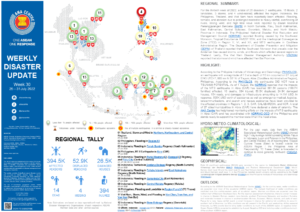
REGIONAL SUMMARY:
For the thirtieth week of 2022, a total of 25 disasters (1 earthquake, 15 floods, 2 landslides, 3 storms, and 4 wind-related) affected the region. Indonesia, the Philippines, Thailand, and Viet Nam have reportedly been affected. Flooding, tornado, and abrasion due to prolonged moderate to heavy rainfall, overflowing of rivers, strong wind, and high tidal wave were reported by Badan Nasional Penanggulangan Bencana (BNPB) in North Sumatra, Riau, South Kalimantan, East Kalimantan, Central Sulawesi, Gorontalo, Maluku, and North Maluku Province in Indonesia. The Philippines’ National Disaster Risk Reduction and Management Council (NDRRMC) reported flooding caused by the Southwest Monsoon, Tropical Disturbance INVEST 95W, and the Intertropical Convergence Zone (ITCZ) in Region V, VI, and XII, and M7.0 earthquake in Cordillera Administrative Region. The Department of Disaster Prevention and Mitigation (DDPM) of Thailand reported that the Southwest Monsoon that prevails over the Andaman Sea caused storms, winds, and floods which affected several regions in Thailand. Lastly, The Viet Nam Disaster Management Authority (VNDMA) reported that storms and wind have affected Yen Bai Province.
HIGHLIGHT:
According to the Philippine Institute of Volcanology and Seismology (PHIVOLCS), an earthquake with a magnitude of 7.0 at a depth of 15 km occurred on 27 July at 0743 UTC+7, 003 km N 50o W of Tayum, Abra (Cordillera Administrative Region), Philippines. According to the PHIVOLCS, this earthquake DID NOT have a TSUNAMI POTENTIAL. As of 1 August, the NDRRMC reported that the impacts of the M7.0 earthquake in Abra (CAR) has reached 381.6K persons (100.7K families) affected, 10 deaths, 394 injured, 50.5K displaced, 24.9K damaged houses, 154 roads, and damages to infrastructure amounting to 14.1M USD. In response, 505K USD worth of assistance as well as emergency medical, logistics, telecommunications, and search and rescue assistance have been provided to the affected provinces in Regions 1, 2, 3, CAR, CALABARZON, and NCR. A total of 27 cities/municipalities in Abra (CAR) have declared a state of calamity. The AHA Centre has heightened monitoring efforts on the impacts of M7.0 earthquake in Abra (CAR) and has coordinated with NDRRMC-OCD of the Philippines and stands ready to support the member state when the need arises.
HYDRO-METEO-CLIMATOLOGICAL:
For the past week, data from the ASEAN Specialised Meteorological Centre (ASMC) showed high 7-day average rainfall spreading across Papua in Indonesia; Luzon and Palawan in the Philippines; and Central Thailand. As of reporting time, Tropical Cyclone Trases (Ester) is located outside the ASEAN Region / the Philippines Area of Responsibility. TC Trases (Ester) is forecasted to continue to move generally northward (PAGASA, JTWC).
GEOPHYSICAL:
Eight (8) significant earthquakes (M>5.0) were recorded in the region by Indonesia’s Badan Meteorologi, Klimatologi, dan Geofisika (BMKG), PHIVOLCS, and Thailand Meteorological Department (TMD). Mount Semeru (alert level III) and Ibu (alert level II), and Taal Volcano (alert level 1), Bulusan Volcano (alert level 1), and Mount Kanlaon (alert level 1) in the Philippines reported recent volcanic activity according to the Pusat Vulkanologi dan Mitigasi Bencana Geologi (PVMBG) and the Philippine Institute of Volcanology and Seismology (PHIVOLCS).
OUTLOOK:
According to the ASEAN Specialised Meteorological Centre (ASMC), for the coming week, wetter conditions are expected over most of the equatorial ASEAN region. The highest likelihood of wetter conditions are predicted over the central-eastern parts of equatorial region. Warmer conditions are expected over the northern half of Mainland Southeast Asia. For the regional assessment of extremes, there is a small increase in chance in Western Borneo, western Java Islands, southern Peninsular Malaysia, and southern Sumatra and moderate increase in chance in southern/eastern Borneo, Sulawesi, Maluku Islands, and parts of west Papua for a very heavy rainfall event; a small increase in chance for extreme hot conditions to occur in southern half of Myanmar. La Niña conditions are still present in the Pacific and weakening. At the seasonal timescale, La Niña events tend to bring wetter conditions to much of the ASEAN region. A negative Indian Ocean Dipole (IOD) is expected to establish by August. Negative IOD tend to bring wetter conditions to much of the southern ASEAN region.
Sources:
ASEAN Disaster Monitoring & Response System (DMRS); ASEAN Specialised Meteorological Centre (ASMC); Joint Typhoon Warning Centre (JTWC);
Indonesia: BNPB, BMKG, PVMBG;
Philippines: NDRRMC, PAGASA, PHIVOLCS, DSWD;
Thailand: DDPM; TMD;
Viet Nam: VNDMA;
Various news agencies.







